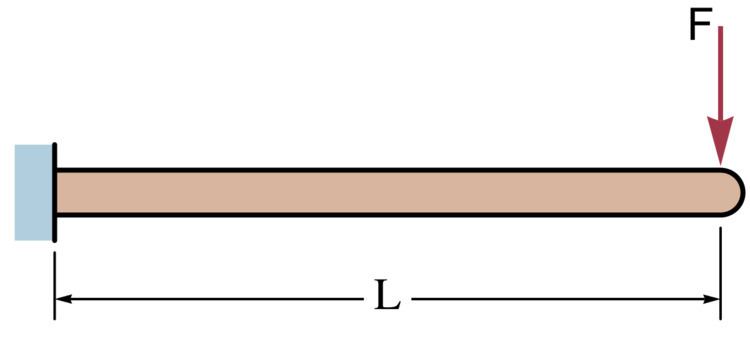 | ||
In engineering, deflection is the degree to which a structural element is displaced under a load. It may refer to an angle or a distance.
Contents
- Beam deflection for various loads and supports
- Cantilever beams
- End loaded cantilever beams
- Uniformly loaded cantilever beams
- Simply supported beams
- Center loaded simple beams
- Off center loaded simple beams
- Uniformly loaded simple beams
- Units
- International system SI
- US customary units US
- Others
- Structural deflection
- References
The deflection distance of a member under a load is directly related to the slope of the deflected shape of the member under that load and can be calculated by integrating the function that mathematically describes the slope of the member under that load. Deflection can be calculated by standard formula (will only give the deflection of common beam configurations and load cases at discrete locations), or by methods such as virtual work, direct integration, Castigliano's method, Macaulay's method or the direct stiffness method, amongst others. The deflection of beam elements is usually calculated on the basis of the Euler–Bernoulli beam equation while that of a plate or shell element is calculated using plate or shell theory.
An example of the use of deflection in this context is in building construction. Architects and engineers select materials for various applications. The beams used for frame work are selected on the basis of deflection, amongst other factors.
Beam deflection for various loads and supports
Beams can vary greatly in their geometry and composition. For instance, a beam may be straight or curved. It may be of constant cross section, or it may taper. It may be made entirely of the same material (homogeneous), or it may be composed of different materials (composite). Some of these things make analysis difficult, but many engineering applications involve cases that are not so complicated. Analysis is simplified if:
-The beam is originally straight, and any taper is slight-The beam experiences only linear elastic deformation-The beam is slender (its length to height ratio is greater than 10)-Only small deflections are considered (max deflection less than 1/10 the span).In this case, the equation governing the beam's deflection (
where the second derivative of its deflected shape with respect to
If, in addition, the beam is not tapered and is homogeneous, and is acted upon by a distributed load
This equation can be solved for a variety of loading and boundary conditions. A number of simple examples are shown below. The formulas expressed are approximations developed for long, slender, homogeneous, prismatic beams with small deflections, and linear elastic properties. Under these restrictions, the approximations should give results within 5% of the actual deflection.
Cantilever beams
Cantilever beams have one end fixed, so that the slope and deflection at that end must be zero.
End-loaded cantilever beams
The elastic deflection
where
Note that if the span doubles, the deflection increases eightfold. The deflection at any point,
Note that at
Uniformly-loaded cantilever beams
The deflection, at the free end B, of a cantilevered beam under a uniform load is given by:
where
The deflection at any point,
Simply-supported beams
Simply-supported beams have supports under their ends which allow rotation, but not deflection.
Center-loaded simple beams
The elastic deflection (at the midpoint C) of a beam, loaded at its center, supported by two simple supports is given by:
where
The deflection at any point,
for
Off-center-loaded simple beams
The maximum elastic deflection on a beam supported by two simple supports, loaded at a distance
where
This maximum deflection occurs at a distance
Uniformly-loaded simple beams
The elastic deflection (at the midpoint C) on a beam supported by two simple supports, under a uniform load (as pictured) is given by:
where
The deflection at any point,
—–
Units
The formulas supplied above require the use of a consistent set of units. Most calculations will be made in SI or US customary units, although there are many other systems of units.
International system (SI)
Force: newtons (Length: meters (
US customary units (US)
Force: pounds force (Others
Other units may be used as well, as long as they are self-consistent. For example, sometimes the kilogram force (
Structural deflection
Building codes determine the maximum deflection, usually as a fraction of the span e.g. 1/400 or 1/600. Either the strength limit state (allowable stress) or the serviceability limit state (deflection considerations amongst others) may govern the minimum dimensions of the member required.
The deflection must be considered for the purpose of the structure. When designing a steel frame to hold a glazed panel, one allows only minimal deflection to prevent fracture of the glass.
The deflected shape of a beam can be represented by the moment diagram, integrated (twice, rotated and translated to enforce support conditions).
